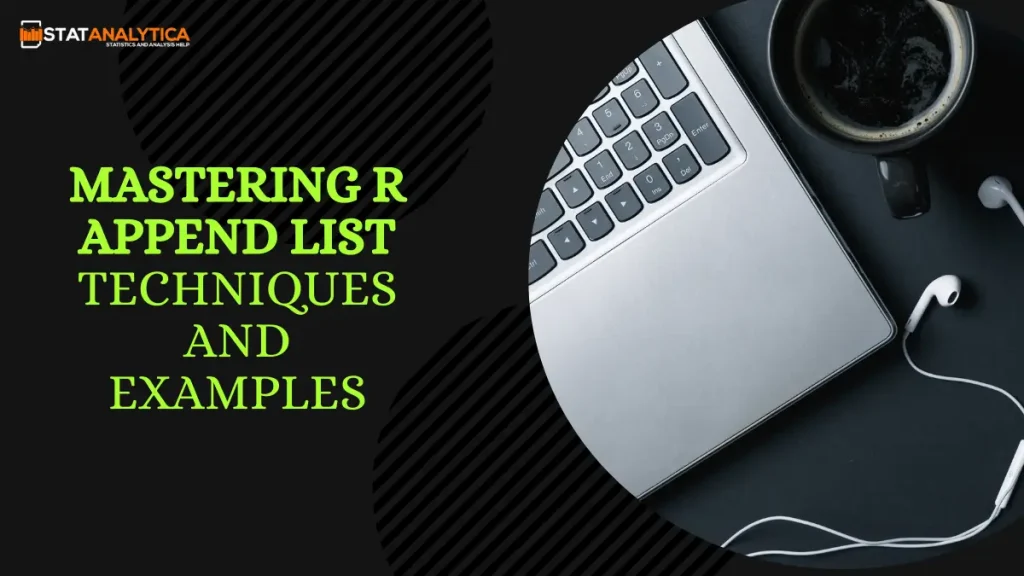Lists in R are helpful because they can store different types of data together, like numbers, text, and even other lists. This makes them great for working with complex data in tasks like data analysis. Sometimes, you may need to add new items to a list, such as extra data or new results.
In this article, we’ll focus on how to use R Append List techniques to do just that. We’ll explain simple ways to append items to a list in R, show when to use each method, and provide easy examples to help you understand and apply these techniques.
What is a List in R?
Table of Contents
In R, a list is a tool for storing different types of data together. Unlike vectors or matrices, which can only hold one kind of data, a list can include numbers, text, vectors, and even other lists.
Here’s what you should know about lists:
- Variety: Lists can hold many types of data at once. For example, you can have a list with a number, a word, and another list all in one.
- Names for Items: You can name the items in your list, which makes them easier to find and use.
- Accessing Items: To get items from a list, you use double square brackets [[]]. You can also use the names you gave to find specific items.
Example:
Creating a list
my_list <- list(name = “Alice”, age = 25, scores = c(90, 85, 88))
Accessing elements
my_list$name Gives “Alice”
my_list$scores Gives c(90, 85, 88)
Lists are useful when you need to store different types of information together or work with complex data.
R Append List: 10 Easy Methods to Append List Items in R: Simple Methods and Examples
Here are the ten easy methods with can append a list in R
1. Using the c() Function
Explanation: The c() function lets you combine lists, so it’s a simple way to add new items to the end of your existing list.
Example:
Starting list
my_list <- list(name = “John”, age = 30)
Adding new items
my_list <- c(my_list, list(favorite_fruits = c(“Apple”, “Banana”, “Cherry”)))
Result
my_list
Output:
$name
[1] “John”
$age
[1] 30
$favorite_fruits
[1] “Apple” “Banana” “Cherry”
2. Using the append() Function
Explanation: The append() function adds new items to the end of your list. You can also choose where to add items if needed.
Example:
Starting list
my_list <- list(name = “Sarah”, age = 25)
Adding new items at the end
my_list <- append(my_list, list(hobbies = c(“Reading”, “Hiking”, “Cooking”)))
Result
my_list
Output:
$name
[1] “Sarah”
$age
[1] 25
$hobbies
[1] “Reading” “Hiking” “Cooking”
3. Using Indexing
Explanation: You can add new items by putting them in a new position in your list. Using length(my_list) + 1 make sure your new item goes to the end.
Example:
Starting list
my_list <- list(name = “Mike”, age = 40)
Adding new items at the end
my_list[[length(my_list) + 1]] <- list(pets = c(“Dog”, “Cat”))
Result
my_list
Output:
$name
[1] “Mike”
$age
[1] 40
[[3]]
$pets
[1] “Dog” “Cat”
4. Using the list() Function
Explanation: Create a new list with the items you want to add, and then combine it with your original list using c().
Example:
Starting list
my_list <- list(name = “Emily”, age = 35)
New items to add
new_items <- list(favorite_colors = c(“Red”, “Blue”, “Green”))
Combining the lists
my_list <- c(my_list, new_items)
Result
my_list
Output:
$name
[1] “Emily”
$age
[1] 35
$favorite_colors
[1] “Red” “Blue” “Green”
5. Using modifyList()
Explanation: The modifyList() function updates your list with new items. It’s a good way to merge or add elements.
Example:
Starting list
my_list <- list(name = “Laura”, age = 28)
New items to add
additional_items <- list(favorite_books = c(“1984”, “To Kill a Mockingbird”))
Updating the list
my_list <- modifyList(my_list, additional_items)
Result
my_list
Output:
$name
[1] “Laura”
$age
[1] 28
$favorite_books
[1] “1984” “To Kill a Mockingbird”
6. Using the <<- Operator
Explanation: The <<- operator changes a variable in a parent environment, which is useful for updating lists from different places in your code.
Example:
Starting list in the global environment
my_list <<- list(name = “David”, age = 50)
Adding new items
my_list <<- c(my_list, list(countries_visited = c(“France”, “Japan”, “Brazil”)))
Result
my_list
Output:
$name
[1] “David”
$age
[1] 50
$countries_visited
[1] “France” “Japan” “Brazil”
7. Using rbindlist() from the data.table Package
Explanation: If your list contains data frames, brindles () can combine them or add new rows. This is great for managing tables of data.
Example:
library(data.table)
Starting list with a data frame
my_list <- list(data.frame(name = “Anna”, age = 22))
Adding a new data frame
new_df <- data.frame(name = “Mark”, age = 29)
my_list <- rbindlist(c(my_list, list(new_df)))
Result
my_list
Output:
name age
1 Anna 22
2 Mark 29
8. Using c() with Named Elements
Explanation: When you add new items, you can use c() with names to keep your list organized and clear.
Example:
Starting list
my_list <- list(name = “Tina”, age = 33)
Adding named items
my_list <- c(my_list, list(favorite_songs = c(“Song A”, “Song B”), city = “Chicago”))
Result
my_list
Output:
$name
[1] “Tina”
$age
[1] 33
$favorite_songs
[1] “Song A” “Song B”
$city
[1] “Chicago”
9. Using lapply() for Multiple Appends
Explanation: Use lapply() to add multiple items to your list easily. It applies a function to each element and helps in updating the list with several new elements.
Example:
Starting list
my_list <- list(name = “Rachel”, age = 27)
Items to add
items_to_add <- list(hobbies = c(“Yoga”, “Photography”), favorite_foods = c(“Pizza”, “Pasta”))
Adding items
my_list <- lapply(names(items_to_add), function(x) {
my_list[[x]] <- items_to_add[[x]]
return(my_list)
})[[1]]
Result
my_list
Output:
$name
[1] “Rachel”
$age
[1] 27
$hobbies
[1] “Yoga” “Photography”
$favorite_foods
[1] “Pizza” “Pasta”
10. Using data.frame() for Structured Lists
Explanation: If your list contains data frames, you can use data.frame() to add new rows or columns. It’s useful for managing structured data.
Example:
Starting data frame list
my_list <- list(data.frame(name = “Chris”, age = 45))
Adding a new row
new_row <- data.frame(name = “Ella”, age = 34)
my_list <- list(rbind(my_list[[1]], new_row))
Result
my_list
Output:
name age
1 Chris 45
2 Ella 34
These explanations and examples help you understand how to add items to lists in R simply and straightforwardly.
How to Prevent Common Errors When Appending to Lists in R
1. Mixing Up c() and append()
- Mistake: Use c() when you need to add items at a specific place in your list.
- How to Avoid: Use c() to add items to the end of the list. If you need to put items in a certain spot, use append().
2. Flattening the List
- Mistake: Accidentally changing your list’s shape when using c() or append().
- How to Avoid: Check the list after adding items. If you want to keep the list’s shape, use functions that handle lists correctly.
3. Replacing Existing Items
- Mistake: Changing items you already have in the list when you just want to add new ones.
- How to Avoid: Be careful where you add new items. Make sure you add them without changing the existing items.
4. Misusing modifyList()
- Mistake: Using modifyList() when your lists don’t have overlapping names, which doesn’t work as expected.
- How to Avoid: Only use modifyList() if you’re updating items with the same names in both lists. For other situations, use c() or append().
5. Forgetting to Install or Load Packages
- Mistake: Trying to use functions from packages like data.table without installing or loading them first.
- How to Avoid: Install the package with install.packages(“data.table”) and load it with library(data.table) before using its functions.
6. Ignoring Data Types
- Mistake: Adding different types of data to your list without checking if they mix well.
- How to Avoid: Make sure the data types you’re adding work well together or convert them if needed.
7. Assuming Functions Are the Same
- Mistake: Thinking that all functions like c(), append(), and modifyList() work the same way.
- How to Avoid: Know what each function does. Use c() for quick additions, append() for specific spots, and modifyList() for updating lists with similar names.
Final Words
Knowing how to add items to lists in R is really useful for working with data. You can use c() to add things to the end of your list quickly, append() to put items in a specific spot, and modifyList() to update lists with matching names.
Be careful to avoid common mistakes, like using the wrong function or mixing up data types. By following the tips we discussed, you’ll manage your lists better and avoid errors.
Keep practicing with these methods, and you’ll learn to append to lists in R. Happy coding!
Also Read
How Long Does It Take to Learn R Programming?
8 No-Brainer Programming Languages For Robotics For 2023
What should I do if my list has different types of data?
R lists can handle different types of data, but make sure the new data you add fits well with the existing ones. Managing data types carefully helps avoid problems.
What if I forget to install or load a package like data.table?
If you try to use a function from a package that isn’t installed or loaded, R will give you an error. To fix this, install the package with install.packages(“data.table”) and load it with library(data.table).
Can I use indexing to add items to a specific place in a list?
Yes, you can use indexing (like list[[index]] <- new_item) to put items in a specific spot. Just remember, this will replace the item at that spot. If you want to add without replacing, use append()


